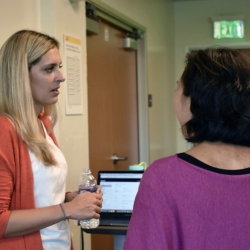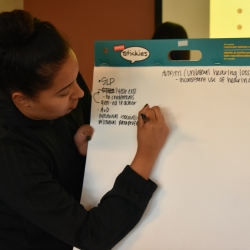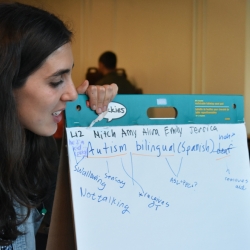Case Studies in IPE
The development and implementation of case studies are central to IPE, designed to prepare future professionals in the art and science of collaborative practice. IPE case studies differ from other types of case studies that are used in professional education for various purposes, such as testing one’s knowledge of particular human conditions related to specific professions. In the field of speech, language and hearing sciences, the focus of professional preparation includes nine core areas, referred to as the “Big Nine” required for ASHA certification for speech-language pathologists. For details on the nine areas of study, see ASHA 2020 SLP Certification Standard IV-C.
Case studies developed for IPE center on the integration of interprofessional competencies within each student’s professional development, rather than specific content knowledge in their disciplines. Over the last decade, research and development in IPE and IPP continue to inform the spectrum of health, education and human services professions. The emergence of interprofessionalism as a unique and unifying set of knowledge and skills across disciplines provides a basis for the structure and implementation of case studies that are designed for the purpose of advancing interprofessional competencies within and across disciplines. Interprofessional resources in several disciplines identify four parameters to consider in the design, discussion, competency assessment and sample bank of IPE case studies including the following:
- Design and development of IPE case studies
- Discussion questions for IPE cases
- IPE competency development assessment
- Sample bank of IPE case studies
Each of the above parameters of IPE case studies are highlighted below, with application to speech, language and hearing sciences.

Design and Develop IPE Case Studies
The design of case studies to provide discussion experiences for IPE events requires attention to outcomes. Faculty determine the goals of the discussion for students, and build case studies accordingly. In SLHS, a starting point to frame case studies is to select one or more of the nine areas of study in speech-language pathology or audiology. The next consideration are the IPEC competencies in broad areas defined and described in detail in the IPEC Core Competencies for Collaborative Practice, 2016 Updates. Guidelines for developing IPE Case studies structured with an eye to student outcomes are further discussed in ASHA’s eBook on IPE and IPP in CSD, specifically in Chapter 2.

IPE Competency Assessment
Mastery of IPE skills require continued practice. In SLHS, we have used the IPEC Competency Self-Assessment Tool, available from the National Center for Interprofessional Practice and Education for students to gauge their own development of IPE competencies. To date, we have implemented the IPEC Competency Self-Assessment at the beginning and end of each IPE event so that students may reference their strengths and areas for further development related to communication, teamwork, understanding of diverse professions, family partnerships, and more. Research to advance and validate IPE competency assessment is available from the Interprofessionalism Assessment Collaborative.

Discussion Questions for IPE Cases
In order to guide the discussion so that students build skills for collaborative practice, reflection questions for case studies need to lead toward identifying improved coordination and outcomes for the families and individuals at the center of the professional team. For example, three reflections to guide discussions are: (See ASHA’s eBook on IPE and IPP in CSD, Chapter 1).
- Identify key opportunities to improve care in the specific case;
- Consider factors of quality, outcome, or cost; and
- Identify strategies to improve for the family, individuals, team and institution.
Additionally, considerations of cultural and linguistic diversity provide a lens for students to apply.

Sample Bank of IPE Case Studies
Case studies are a main component of IPE events in which students and pre-professionals collaborate with each other to provide the highest quality client care. There are a variety of disorders represented within IPE case study models which focus on ASHA’s Big Nine. Two case studies developed by SLHS, based on ASHA guidelines, are provided for here downloading and adaptation:
In each of the above case studies, multiple focus areas were addressed including family cultural and linguistic diversity, bilingual language learning, Autism Spectrum Disorder, hearing needs, school inclusion. Additional resources for finding and developing IPE case studies are available in Chapter 1 of ASHA’s eBook on IPE and IPP in CSD.
For PDF files, you'll need Adobe Acrobat 5.0 or above to view it. If you need Adobe Acrobat Reader it's available free from Adobe.